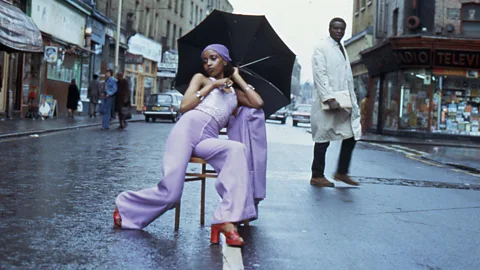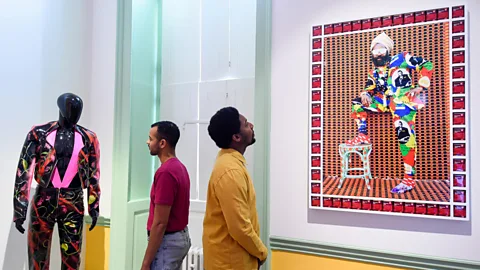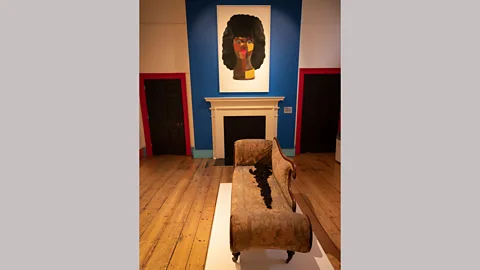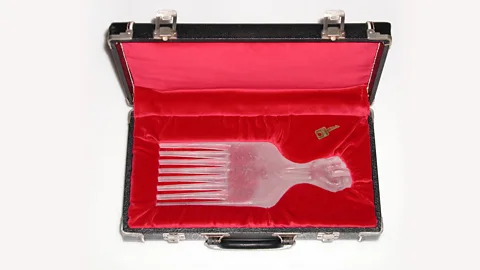Style, beauty and black identity

An exhibition explores style, beauty and black identity. Are we getting any closer to proper representation – and a real understanding, asks Precious Adesina.
In matters of taste and beauty, fashion has long been perceived as a standard by which to measure ourselves. But what does that mean for black people, who are often marginalised, misrepresented and stereotyped by the world of fashion? The exhibition Get Up, Stand Up Now at London’s Somerset House looks at the past 50 years of black creativity, and touches on the representation of black people in fashion (or the lack of it). It also raises an important question about representing people of colour appropriately.
More like this:
There have been plenty of times in fashion when a thin white woman is photographed on location in the developing world, with people of colour in the background. In 2016, Valentino typified this trope, with the advertising images for its ‘African inspired’ spring/summer collection. Disregarding the vagueness of the term ‘African’, the phrase could have been perceived as an appreciation of African culture and the black people who inherit it – except that the models in the images were predominantly white women and wore bone necklaces and cornrows. Most of the black people in the photographs were seen from afar, as an ornamental backdrop.

Even on the catwalk for the same collection, Valentino missed the opportunity to feature people of colour. “The African-inspired looks, the braids, and even the predominantly white casting might have gone unremarked separately, but to many observers the combination seemed uncomfortably close to a 21st-Century couture version of performers wearing blackface,” Susan Scafidi, founder of the Fashion Law Institute, told The Fashion Spot.
Photographer Armet Francis – whose work is showing at Get Up, Stand Up Now – has for decades been making black people the protagonists of his images, which are shot in neighbourhoods his subjects are familiar with. In the 1973 photograph titled Fashion Shoot Brixton Market, a black woman in a bold purple outfit poses on the road. The singular image holds weight when considered alongside the more recent Valentino pictures. And why Francis considers his fashion photography a form of social documentary also becomes apparent.
 Courtesy of the artist
Courtesy of the artistBut even if Valentino had used more people of colour, would they have been represented in an empowering way? Fashion critic Robin Givhan told The Cut: “If we don’t consider how the fashion industry is embracing, showing or including various people, then we risk allowing whole groups to be, if not devalued, then ignored.”
Artist Hank Willis Thomas highlights the importance of how black people are depicted. Thomas appropriates adverts aimed at black people, removing all the branding in order to emphasise the sort of imagery that is regularly absorbed. Freedom isn’t Always Beautiful depicts a black woman in lingerie, surrounded by a jungle-like backdrop and a tiger, which could be seen as a commentary on the frequently sexualised and primitive representation of black people.
 Getty Images
Getty ImagesIt should also be said, though, that over the past few years the representation of black people in fashion (without stereotypes or tokenism) has increased. Last September, several black women featured on the covers of some of the top fashion magazines in the UK. Rihanna was on the cover of British Vogue, Lupita Nyong’o on Porter Magazine, Ruth Negga on Marie Claire UK, and a pregnant Slick Woods on the front of Elle.
 Getty Images
Getty ImagesWhile many black women have previously featured on the covers of such magazines, the surprise last year was the sheer number of them all at once. “This is definitely unprecedented, seeing so many women of colour on so many mass-market influential magazines,” said Kenya Hunt, deputy editor of Elle UK, at the time. “We didn't go into it thinking we wanted to have a black woman on the cover and we rarely do.”
Black is beautiful
But it’s not just about representing black people positively, it is also about a deeper level of understanding. Back in 2017, Nyong’o donned her natural hair on the front cover of Grazia. To her surprise, her afro hair disappeared from the final cut. At the time the actress tweeted: “Disappointed that @GraziaUK edited out and smoothed my hair to fit a more Eurocentric notion of what beautiful black hair looks like.” Although the photographer apologised for his “unbelievably damaging and hurtful act” in a statement, the incident spoke volumes about fashion’s attitude to black body image – and especially hair, a topic discussed in Get Up, Stand Up Now.

US artist David Hammons’s 2001 work Hair Relaxer explores the multifaceted relationship black people have with their hair as a result of societal constraints. Black hair is frequently straightened or ‘relaxed’ to suit Eurocentric standards, though both the Black Panther movement of the 1960s and the natural hair movement of the 2000s have fought to resist this. In his piece, afro hair is neatly scattered on a chaise-lounge, an item of furniture often seen in depictions of female beauty in European art. The curator references Jacques-Louis David’s Portrait of Madame Récamier (1800) in its description. In Hammons’s artwork, in place of the attractive woman is the kinky hair.
In the same vein, the artwork IcePick by Satch Hoyt consists of an opaque-glass afro pick in a red velvet upholstered clarinet case which the artist describes as “coffin-like”. Alongside it, the soundscape is of writer-activist Michaela Angela Davis and poet-vocalist LaTasha N Nevada Diggs, combing their afros with different picks of varied materials. “The afro pick is a cultural signifier, a political slogan,” Hoyt tells BBC Culture. “It was not so long ago that to wear one’s hair natural was a taboo. Even today, there are certain places in the world, like Colombia, where if one wears their hair natural one cannot find employment.”
 Courtesy of the artist
Courtesy of the artistHoyt goes on to mention the 1960s, a time when black power was associated with the afro thanks to the Black Panther movement whose members grew their natural hair out and wore a uniform of a blue shirt and black leather jacket, trousers, shoes, beret, and optional gloves creating a sense of solidarity among blacks that transcended class or any other divide.
Yet the exhibition has positive messages, too, highlighting fashion designers who are actively and consistently representing black people in a favourable light. Both Grace Wales Bonner and Mowalola Ogunlesi challenge misconceptions of black masculinity. Their models are neither hyper-masculine nor overly-sexualised, instead offering a more nuanced perception of black men that contrasts with the more usual stereotypes.
 Getty Images
Getty ImagesIn an interview, Bonner said her work is a personification of the men she personally knows who don’t conform to common assumptions about what it means to be black and male. “It’s a reflection of my relationships with the men and boys in my life. It’s about real characters in my life. They inspire me and the direction of my collections,” she said. Ogunseli also previously called her work “a celebration of the black African male: his culture, sexuality, and desires”.
Both designers not only represent black people, but also shape the way they are perceived. Still, it is hard not to wonder when the struggle for a non-discriminatory representation of black people in fashion won’t be down to just a few artists or designers, but will become the responsibility of the fashion industry as a whole.
Get Up, Stand Up Now: Generations of Black Creative Pioneers is at Somerset House, London, until 15 September.
And if you liked this story, sign up for the weekly bbc.com features newsletter, called “If You Only Read 6 Things This Week”. A handpicked selection of stories from BBC Future, Culture, Worklife and Travel, delivered to your inbox every Friday.
